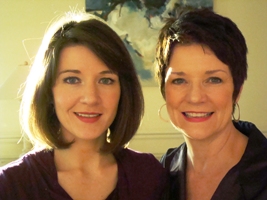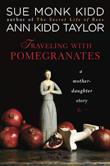 What did Sue Monk Kidd and Ann Kidd Taylor learn about each other as they wrote TRAVELING WITH POMEGRANATES? Why does Sue call it "the hardest book" she ever wrote? Read on to find out the memories their writing dredged up, as well as the question we were mulling --- did they devour pomegranates as they wrote?
What did Sue Monk Kidd and Ann Kidd Taylor learn about each other as they wrote TRAVELING WITH POMEGRANATES? Why does Sue call it "the hardest book" she ever wrote? Read on to find out the memories their writing dredged up, as well as the question we were mulling --- did they devour pomegranates as they wrote?
What made you decide to write together?
Ann: Writing TRAVELING WITH POMEGRANATES together was my idea. Initially, though, I set out to write the book by myself. I worked on it for years, writing about the travels that my mother and I made during my 20s and my considerable struggle to find my way as a young woman after college. Eventually, I realized I was only telling half of the story. My mother had experienced her own struggles during that time as she turned 50. It just hit me one day that the book was really about both my mother and I crossing thresholds together and reinventing both ourselves and our relationship. I felt like m y mother’s story and her voice needed to be in there. Around my 27th birthday, while talking with Mom about something totally unrelated, I heard myself say, "Why don’t you write this book with me?" That was in the Spring of 2003 when she was gearing up to write THE MERMAID CHAIR. My timing couldn’t have been worse. But to my surprise, she said, "I’d love to." Then she paused, and sounding very serious, added, "But I want you to be really… really sure." I did feel sure…until she said that.
y mother’s story and her voice needed to be in there. Around my 27th birthday, while talking with Mom about something totally unrelated, I heard myself say, "Why don’t you write this book with me?" That was in the Spring of 2003 when she was gearing up to write THE MERMAID CHAIR. My timing couldn’t have been worse. But to my surprise, she said, "I’d love to." Then she paused, and sounding very serious, added, "But I want you to be really… really sure." I did feel sure…until she said that.
 y mother’s story and her voice needed to be in there. Around my 27th birthday, while talking with Mom about something totally unrelated, I heard myself say, "Why don’t you write this book with me?" That was in the Spring of 2003 when she was gearing up to write THE MERMAID CHAIR. My timing couldn’t have been worse. But to my surprise, she said, "I’d love to." Then she paused, and sounding very serious, added, "But I want you to be really… really sure." I did feel sure…until she said that.
y mother’s story and her voice needed to be in there. Around my 27th birthday, while talking with Mom about something totally unrelated, I heard myself say, "Why don’t you write this book with me?" That was in the Spring of 2003 when she was gearing up to write THE MERMAID CHAIR. My timing couldn’t have been worse. But to my surprise, she said, "I’d love to." Then she paused, and sounding very serious, added, "But I want you to be really… really sure." I did feel sure…until she said that. Can you each share a story about one of the books you wrote together?
Sue: When people discovered that Ann and I were writing a book together, often their firstreaction was: "Are you two still speaking?" We got this comment so often, it became funny, and then sort of revealing, suggesting just how loaded the mother-daughter world can be. The good news is that we are indeed still speaking, and in fact, I think Ann and I would both say that writing the booktogether deepened our relationship. I teased Ann that our collaboration was also very informative. I discovered that during her college trip to Greece, she met a handsome Greek student with whom she danced on a tabletop, then kissed on the sidewalk in the shadow of the Acropolis. I learned she’d been determined not to become a writer in order to separate herself from me, because I’m a writer. I got enlightened about something like thisnearly everyday. Co-authoring with Ann was a real gift, but in the interest of full disclosure, I should say it was not easy. TRAVELING WITH POMEGRANATES is the hardest book I’ve ever written, hands down. But it is also the most satisfying.
Ann: In the book, Mom and I write in alternating chapters. The first time we exchanged chapters in order to read each other’s work, I was surprised to find she had written a little profile of me: "If you asked me to describe Ann, I would say…" I paused there, realizing you don’t get to see yourself through your mom’s eyes all that often. I was intrigued. She wrote that while other 8-year-olds were busy setting up lemonade stands, I set up a booth for dispensing "Advice for People with Problems." Minor problems cost a nickel, major ones a dime. I made a killing on it. Mom also mentioned that as a little girl, I insisted everyone in the house should carry insects outside in dustpans rather than exterminate them (I still do that.) She wrote that the qualities she most associated with me were inventiveness and tenderheartedness. I hadn’t known that till I read it in print. One of the great things about moms is they see things in us we can’t always see ourselves.
How do you share your writing responsibilities?
Sue: We split the writing responsibilities right down the middle. For us, the process worked like this: We had a joint discussion about the chapters we were each about to write. Then we worked separately --- me writing at my house and she at hers, 15 minutes away. When we each had a first draft, we got together and exchanged chapters, reading what one another had written. Afterward, we gave each other ideas and suggestions, then revised the work until we had good enough drafts to go on to the next chapters. That went on for three years, which was how long it took to finish the book.
Do you outline, or do you write as the story unfolds?
Sue: We loosely mapped the whole book out ahead of time. The outline wasn’t a typical one. We didn’t write it so much as we drew it on poster-size paper that we then hung on the wall. The drawing was composed of three lines, each representing a layer of the story. Ann’s individual story line was green, mine was red, and there was a third line in purple that represented the mother-daughter story, which belonged to both of us. The three lines converged and diverged as they flowed to designated places that Ann and I had visited during our travels --- Athens, Eleusis, Ephesus, Le Puy-en-Velay, etc. Our job was to pull those ‘threads’ from place to place all the way to the end and make sure they were always woven together.
Who has final say? Does "Mom always rule," or how do you handle writing conflicts?
Ann: It’s true I was the novice and Mom was the one with the experience, but nevertheless the book was a true collaboration. That meant no one had veto power. Mostly, the two of us were on the same page about most things --- luckily we are pretty compatible. But every now and then, we had different opinions. Whenever that happened, we just tried to really listen to one another, then debate, negotiate and be flexible. I changed numerous things at my mother’s suggestion, and she changed things at mine. But we also agreed that, in the end, if a suggestion didn’t feel right we didn’t have to take it. Above all, we needed to feel that our own individual work was true to us, that it was our authentic voices coming through. As for writing conflicts, there was nothing big; nobody ever stormed out of a room or anything like that. The biggest difference we had was in our writing styles. Mom writes slowly, while I write fast. Sometimes that drove us both a little crazy.
What do each of you bring to the table?
Sue: When working on the book, Ann showed an unexpected vulnerability, a willingness to be brutally honest about her life. Along with that, she brought an amazing story about a young woman (herself) leaving college, losing herself, falling into depression, then having to find her way again. She also has such a sharp, creative, contemporary voice. Plus, Ann brings a lot of humor to the table, some of it sardonic, even wicked, and some of it endearingly self-deprecating.
Ann: What does my mother bring to the table? Oh, where to start. Maybe with the remarkable depth she has. She also has a gift for taking her experiences and translating them into a narrative that possesses universal truth. People are always coming up to her saying, "You told my story." Her writing just connects with readers on a deep level. She told me once that while she loved to make people think, what she most wanted to do through her writing was to jolt their hearts. She definitely brings that quality to her books. I could go on, but I’ll leave it at that.
What's your favorite snack food/drink when you are writing?
Sue: When I wrote The THE SECRET LIFE OF BEES, I ate biscuits and honey all the time, but I never quite gravitated to pomegranate seeds or pomegranate juice while I worked on this book. My writing food was hot black tea and chocolate-covered almonds.
Ann: Mom got me hooked on her chocolate-covered almonds. Also, while writing the chapters about our travels in Greece, I had cravings for Kalamata olives. I went through jars of them.
Do you have advice for anyone who would like to write a book with their mother or daughter?
Sue: As co-authors, try to step out of the roles of mother and daughter, in which classic old patterns can insert themselves into the working relationship. Rather, see yourselves as colleagues and creative partners.
Ann: Respect is the key ingredient, respect for one other and for one other’s work.
TRAVELING WITH POMEGRANATES: A Mother-Daughter Story was released in September 2009. Sue Monk Kidd is also the bestselling author of THE SECRET LIFE OF BEES and THE MERMAID CHAIR.

